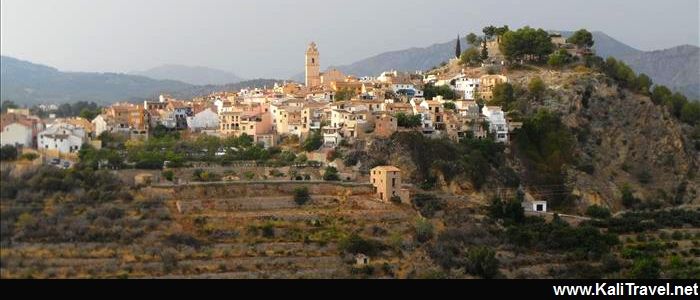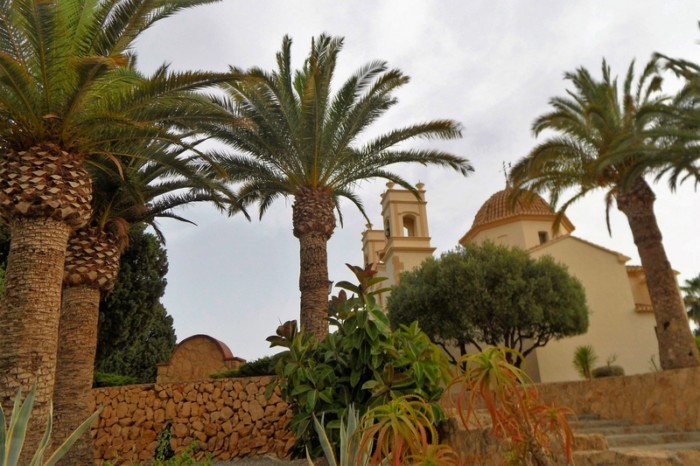La Nucía is a peaceful little town in the Marina Baixa area of Alicante in Spain, only a few kilometres inland from Benidorm and Altea on the deliciously decadent Costa Blanca coast. A fusion of modern amenities and traditional quarters in a rural setting means there’s a lot to see and do.
La Nucía, Costa Blanca (Spain)
With stunning views over to the Mediterranean Sea and Sierra Bernia mountains, and only a short drive from the Guadalest valley, La Nucía’s scenic location in the foothills of Puig Campana makes it the perfect base for a holiday – close to all the activity and a great selection of beaches within easy reach.
La Nucia Old Town

La Nucia’s thriving commercial activity and great variety of restaurants, complements a lively cultural agenda, sports championships, tournaments, exhibitions and festivities.

The comprehensive range of restaurants, in and around town, is enviable serving everything from traditional Spanish cuisine to nouvelle gourmet and a vast selection of popular international eateries, tapas bars… there’s something for every taste and budget.

Turn-off the main street, by the ravine that separates La Nucia from neighbouring Polop (there are fabulous views) and you’ll see the ultra-modern auditorium. The cultural centre features an interesting programme of functions throughout the year, and there’s a convenient underground car park by the installations.

If you’re driving follow the same road right round circling the ‘old town’ to an area where there’s plenty of parking and you can discover the old town on foot. Not surprisingly, strangers don’t realise that the original heart of La Nucía exists; it’s almost a secret!

The beautifully restored original public washhouse overlooks orange and nispero orchards. Steps lead up to a maze of little streets, a picturesque traditional neighbourhood with friendly old folk sitting on their doorsteps and children safely playing outside, a place where artists and craftsmen love to live.

Wander around the pedestrian-friendly old quarters, quaint plazas with wooden pergolas and benches, well-kept traditional townhouses adorned with colourful potted plants, and find your way to the main town square guided by the domes of the church peaking over the rooftops.
The imposing parish church graces Plaza Mayor along with the Town Hall (a beautifully restored historical building) and typical terrace cafés. Enjoy a cool drink and tapas in the summer and hot chocolate with ‘churros’ in winter!

The old school house is another example of carefully restored architecture set in Mediterranean gardens it is now an educational centre, La Seu Universitaria, offering a number of courses through Alicante University. The charming courthouse also merits a mention.
Font de la Favara

There are guided tours in English around the pretty ‘old town’ and out to discover places of interest such as Font de la Favara, a shady picnic spot with a scenic waterfall – amazing because the Marina Baixa can be pretty dry, particularly in late-August when I was last there!

Tossal del Captivador
Below the town, the pretty blue and white painted San Vicente Ferrer chapel is located beside pine woods. This is Tossal del Captivador neighbourhood, an area of protected Mediterranean pine woods crossed by trails and nature walks. Visit the Captivador visitors centre to learn about the history of local life and agricultural traditions through the ages, and the influence of a Mediterranean climate.

Mount Calvari
Sant Rafael chapel and Calvari Mount are set on the hillside behind the main street, offering spectacular views over La Nucia to Altea Bay.

Smart well-kept urbanisations, villas with gardens and pools lay on the outskirts of town – no high-rise here – connected with a good network of roads, and the famous La Nucía roundabouts, probably the first in Spain, to ease traffic flow through the town. Amenities include any number of supermarkets and commercial premises, and services.

Some consider La Nucía the perfect place to live – almost half the local residents are non-Spanish, the many retirees or families from the UK looking for the good life – excellent health services, education which includes English language schooling, sports initiatives, special youth agenda, business lab, eco-allotments, dog parks, warm weather…

Camilo Cano ‘Sports City’
Residents from neighbouring towns visit La Nucía regularly, as the modern facilities are some of the best around, especially the Camilo Cano ‘Sports City’, whose installations are considered to be among the best in Europe. Football pitches, a skate park, trial bike circuit, outdoor pools and lawns, kiddies’ play parks, padel, squash and tennis courts, climbing walls and much more…
The magnificent indoor heated Olympic pool has complimentary Jacuzzis and saunas, plus additional services including physiotherapy and massages.
Two adjacent pavilions incorporate large fully equipped gymnasiums, two floors of studios for dance and gym classes, martial arts, self-defence… The indoor games court hosts national and international competitions, sporting events and dancing championships, with a grandstand to seat the audience. On occasions used as an exhibition hall – the FIFA World Cup was on display for back in 2010, the solid gold trophy under strict security measures when the Spanish team triumphantly brought it home from the South African Tournament.
Markets and Festivities in La Nucía
The famous Sunday morning flea market is one of the oldest, and undoubtedly the best in the whole area, more than 700 interesting stalls along a two kilometre strip on the edge of town. Come along, browse and pick-up a bargain, or arrange to set up your own pitch at the crack of dawn and get rid of all that unused junk… have fun at the same time, then lunch at a local eatery!
Cultural activities, local fiestas, beer festival, traditional dancing and Xmas festivities are some of the highlights on the yearly agenda in La Nucía.
The first prehistoric settlers were attracted by the fresh water springs of these fertile lands between the sea and the mountains. The Iberians were followed by Phoenicians, Romans, and the Moors as the different invaders passed through this part of Spain, and pirate attacks were common in the 16th and 17th centuries.
The name La Nucía comes from the Arabic word Naziha, which means delicious, like the oranges and medlar fruits that are grown locally!

How to Get to La Nucía
Nearest Airports:
51 km Alicante/ El Altet;
140 km Valencia;
146 km San Javier (Murcia).
By Road:
Ap-7 motorway Benidorm exit 65;
Main N-332 Alicante to Valencia:
Distances from La Nuciá to:
- 1.5 to Polop de la Marina on the CV715
- 13.5 to Guadalest village on the CV70
- 9 km to Altea seafront on the CV760
- 5 km to Alfaz de Pí town centre on the CV763
- 8 km to Benidorm town centre on the CV70
- 44 km to Alicante city centre by CV70 / AP-7 south
- 146 km to Valencia city centre by CV70 / AP-7 north

Related posts about the Costa Blanca
(Alicante Province north to south)
- Costa Blanca Beaches and Coastal Resorts with info on outdoor activities, watersports, local history, cuisine, fiestas, getting here…
- Dénia
- Ondara
- Moraira
- Benissa
- Calpe
- Jalón Valley
- Altea
- Alfaz de Pi & El Albir
- La Nucía
- Polop de la Marina
- Guadalest Valley – Guadalest village & reservoir walk
- Guadalest Valley – Benimantell, Beniarda, Benifato, Abdet, Confrides
- Benidorm
- Finestrat
- Finestrat Mountain Walk: Puig Campana
- Villajoyosa
- El Campello
- San Juan beach
- Alicante
- Tabarca Island
- Torrevieja
- Rojales
- Pilar de La Horadada
Discover the World with![]() the blog with a focus on independent travel
the blog with a focus on independent travel



